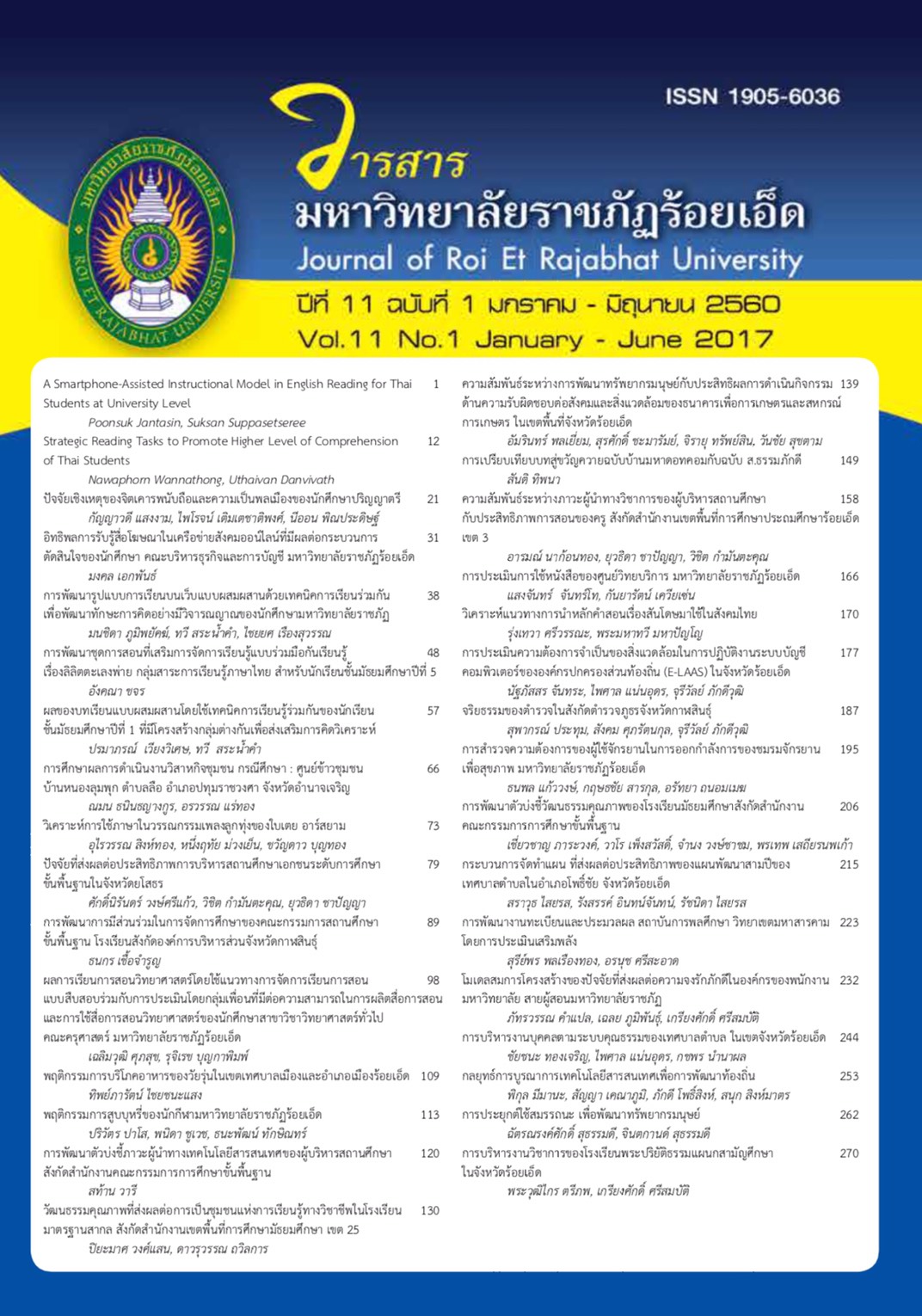วิเคราะห์แนวทางการนำหลักคำสอนเรื่องสันโดษมาใช้ในสังคมไทย
คำสำคัญ:
หลักคำสอนเรื่องสันโดษ, สังคมไทย, แนวปฏิบัติตามหลักคำสอนบทคัดย่อ
งานวิจัยนี้มีจุดมุ่งหมายเพื่อ 1) ศึกษาหลักคำสอนเรื่องสันโดษที่มีในคัมภีร์พระพุทธศาสนาเถรวาท 2) ศึกษาคำสอน รวมถึงแนวปฏิบัติของพระเถระและพระบาทสมเด็จพระเจ้าอยู่หัวรัชกาลที่ 9 และ 3) วิเคราะห์แนวทางการนาหลักคำสอนเรื่องสันโดษมาใช้ในสังคมไทยผลการศึกษาพบว่า ความสันโดษ คือ ความสุขความยินดี ความพอใจของคนเรา ความสันโดษมีความโลภเป็นหลักธรรมที่ตรงกันข้าม มีความเพียรและความไม่ประมาทเป็นธรรมที่สนับสนุน ประโยชน์ของสันโดษนั้นส่งเสริมให้มนุษย์มีจิตใจที่ดี สามารถป้องกันความโลภได้ โดยหลักคำสอนเรื่องสันโดษที่มีในคัมภีร์พระพุทธศาสนานั้น คำว่าสันโดษ มาจากภาษาบาลี ว่า สันตุฏฐี แปลว่า ความยินดี หรือพอใจด้วยของของตน ซึ่งความสันโดษนี้แบ่งออกเป็น ความสันโดษของบรรพชิตเป็นธรรมที่เป็นพื้นฐานให้บรรลุธรรม ส่วนสันโดษสำหรับฆราวาสเป็นธรรมที่ใช้ดำเนินชีวิตการครองเรือนและครองตนจากการศึกษาคำสอน รวมถึงแนวปฏิบัติในเรื่องความสันโดษ ที่มีอยู่ในพระเถระ และในพระบาทสมเด็จพระเจ้าอยู่หัวรัชกาลที่ 9 พบว่า พระบาทสมเด็จพระเจ้าอยู่หัวและพระเถระทั้ง 5 ท่านมีวิธีการอธิบายหลักคาสอนในเรื่องสันโดษที่แตกต่างกันไป ซึ่งล้วนมีความสอดคล้องตามหลักคำสอนในพระไตรปิฎก ส่วนลักษณะความสันโดษที่ทุกท่านมีเหมือนกันคือ การเป็นผู้ที่มีความยินดีในตนเองการวิเคราะห์แนวทางการนาหลักสันโดษมาใช้ในสังคมไทย พบว่า หลักสันโดษเป็นหลักธรรมที่มีเป็นการแก้ปัญหาจากภายในจิตใจ สู่การแก้ปัญหาภายนอกแบ่งออกเป็นแนวทางการแก้ปัญหาครอบครัว ประการสาคัญคือควรปลูกฝังให้สมาชิกในครอบครัวมีความสันโดษในส่วนแนวทางการแก้ปัญหาเศรษฐกิจ ควรใช้หลักสันโดษประกอบด้วยหลักธรรมข้ออื่นรวมถึงใช้วิธีเศรษฐกิจพอเพียงประยุกต์ใช้กับการประกอบอาชีพของตนตามความเหมาะสม และแนวทางการแก้ไขปัญหาการเมือง ประชาชนผู้มีสิทธิ์เลือกตั้งนักการเมือง ควรมีความยินดีพอใจ พิจารณาเลือกผู้แทนที่มีลักษณะความสันโดษ
เอกสารอ้างอิง
สมเด็จพระศรีนครินทราบรมราชธานี. (2543). รวมธรรมะ. กรุงเทพฯ : อัมรินทร์พริ้นติ้ง แอนด์
พับลิชชิ่งจำกัด.
ธรรมสภาและสถาบันบันลือธรรม. (2549). คำสอนของพ่อ. กรุงเทพฯ : ธรรมสภาและสถาบันบันลือธรรม.
พระธรรมสิงหบุราจารย์. (2547). การทาพระนิพพานให้แจ้ง. กรุงเทพฯ : รุ่งเรืองวิริยะพัฒนาโรงพิมพ์.
พระพรหมคุณาภรณ์ (ป.อ.ปยุตฺโต). (2551). พจนานุกรมพุทธศาสตร์ ฉบับประมวลธรรม. พิมพ์ครั้งที่ 17.
กรุงเทพฯ : โรงพิมพ์มหาจุฬาลงกรณราชวิทยาลัย.
พระไพศาล วิสาโล. (2553). มรรคาแห่งชีวิต. กรุงเทพฯ : พรีมา พับลิชชิ่ง.
พระครูกัลป์ยาณสิทธิวัฒน์. (มปป). เอตทัคคะในพระพุทธศาสนา. กรุงเทพฯ : วัดราชสิทธาราม.
พระมหาวุฒิชัย วชิรเมธี. (2552). เคล็ดลับดับทุกข์. กรุงเทพฯ : พิมพ์ดี.
มหาวิทยาลัยมหาจุฬาลงกรณราชวิทยาลัย. (2535). พระไตรปิฎกภาษาบาลี ฉบับมหามหาจุฬาเตปิฎก 2550. กรุงเทพฯ :
โรงพิมพ์มหาจุฬาลงกรณราชวิทยาลัย.
อานนท์ อิศรากูร ณ อยุธยา. (2515). มนุษย์กับสังคม. พิมพ์ครั้งที่ 2. กรุงเทพฯ : บำรุงนุกูลกิจ.
เผยแพร่แล้ว
รูปแบบการอ้างอิง
ฉบับ
ประเภทบทความ
สัญญาอนุญาต
บทความที่ได้รับการตีพิมพ์เป็นลิขสิทธิ์ของวารสารมหาวิทยาลัยราชภัฎร้อยเอ็ด
ข้อความที่ปรากฏในบทความแต่ละเรื่องในวารสารวิชาการเล่มนี้เป็นความคิดเห็นส่วนตัวของผู้เขียนแต่ละท่านไม่เกี่ยวข้องกับมหาวิทยาลัยราชภัฎร้อยเอ็ด และคณาจารย์ท่านอื่นๆในมหาวิทยาลัยฯ แต่อย่างใด ความรับผิดชอบองค์ประกอบทั้งหมดของบทความแต่ละเรื่องเป็นของผู้เขียนแต่ละท่าน หากมีความผิดพลาดใดๆ ผู้เขียนแต่ละท่านจะรับผิดชอบบทความของตนเองแต่ผู้เดียว





